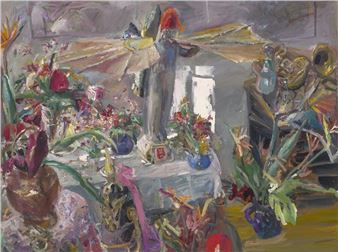Role Models: Women in the MdbK
Since its foundation as a private collection around the middle of the 19th century, the MdbK has housed numerous depictions of women in various roles – as saints, as mothers, as muse, as warring amazons or lascivious femme fatales. Yet works by women artists are underrepresented. This is particularly true of earlier epochs. Why is this? The exhibition seeks answers and offers the opportunity to explore the tension between socially ascribed roles and independent female art practice.
The starting point and source of inspiration is the self-portrait of the American Impressionist Lilla Cabot Perry (1848–1933), which is on display at the MdbK as part of the Collection-in-Residence programme of the Terra Foundation, Chicago. The painter, an acquaintance and patron of Claude Monet, is shown here working at her easel in his house in Giverny. The exhibition juxtaposes the depiction of female creative artistic work as gainful employment – Cabot Perry contributed significantly to the financial sustenance of her family of five – with different forms of artistic activity by women, each of which was characterized by specific social circumstances. These include the exclusion of female applicants from a professional art training as well as obstacles in family life.
The “long” 19th century from the French Revolution up to the time of the Weimar Republic forms the temporal core of the exhibition. Selected “Old Female Masters”, of which the MdbK owns a few, provide a glimpse into the practice and circumstances of earlier centuries. All media represented in the MdbK’s historical collections are included – from painting to drawings and prints to sculpture.
The presentation carries forward the museum’s critical research initiatives into its own collection history. By taking an unbiased look at the stacks, it reveals insights into works that until now have hardly or not at all been shown. At the same time, it opens up new perspectives on the allegedly familiar. The frequently invoked male view of women as mere objects of artistic representation is contrasted with female self-images – here, too, with at times surprising results.

Recommended for you
Since its foundation as a private collection around the middle of the 19th century, the MdbK has housed numerous depictions of women in various roles – as saints, as mothers, as muse, as warring amazons or lascivious femme fatales. Yet works by women artists are underrepresented. This is particularly true of earlier epochs. Why is this? The exhibition seeks answers and offers the opportunity to explore the tension between socially ascribed roles and independent female art practice.
The starting point and source of inspiration is the self-portrait of the American Impressionist Lilla Cabot Perry (1848–1933), which is on display at the MdbK as part of the Collection-in-Residence programme of the Terra Foundation, Chicago. The painter, an acquaintance and patron of Claude Monet, is shown here working at her easel in his house in Giverny. The exhibition juxtaposes the depiction of female creative artistic work as gainful employment – Cabot Perry contributed significantly to the financial sustenance of her family of five – with different forms of artistic activity by women, each of which was characterized by specific social circumstances. These include the exclusion of female applicants from a professional art training as well as obstacles in family life.
The “long” 19th century from the French Revolution up to the time of the Weimar Republic forms the temporal core of the exhibition. Selected “Old Female Masters”, of which the MdbK owns a few, provide a glimpse into the practice and circumstances of earlier centuries. All media represented in the MdbK’s historical collections are included – from painting to drawings and prints to sculpture.
The presentation carries forward the museum’s critical research initiatives into its own collection history. By taking an unbiased look at the stacks, it reveals insights into works that until now have hardly or not at all been shown. At the same time, it opens up new perspectives on the allegedly familiar. The frequently invoked male view of women as mere objects of artistic representation is contrasted with female self-images – here, too, with at times surprising results.
Artists on show
Contact details
















